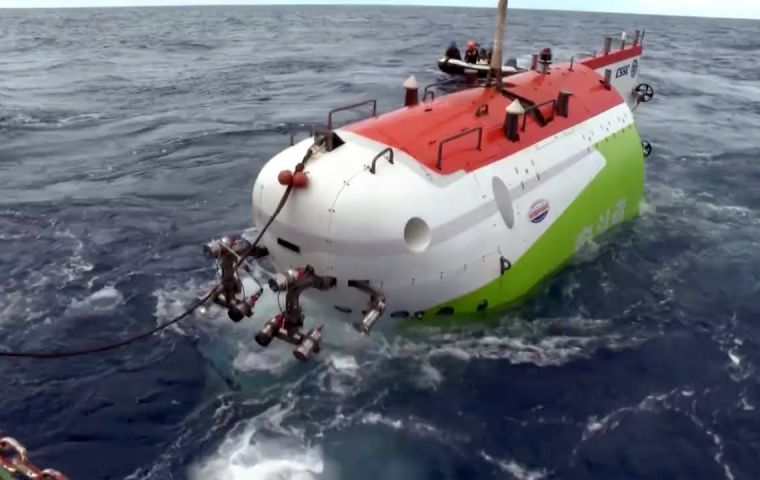MercoPress. South Atlantic News Agency
Chinese submersible exploring the Mariana Trench, the deepest valley on the planet
 The “Fendouzhe”, or “Striver”, descended more than 10,000 meters into the submarine trench in the western Pacific Ocean with three researchers on board
The “Fendouzhe”, or “Striver”, descended more than 10,000 meters into the submarine trench in the western Pacific Ocean with three researchers on board China live-streamed footage of its new manned submersible parked at the bottom of the Mariana Trench on Friday, part of a historic mission into the deepest underwater valley on the planet.
The “Fendouzhe”, or “Striver”, descended more than 10,000 meters into the submarine trench in the western Pacific Ocean with three researchers on board, state broadcaster CCTV said.
Only a handful of people have ever visited the bottom of the Mariana Trench, a crescent-shaped depression in the Earth's crust that is deeper than Mount Everest is high and more than 2,550 kilometers long.
The first explorers visited the trench in 1960 on a brief expedition, after which there had been no missions until Hollywood director James Cameron made the first solo trip to the bottom in 2012.
Cameron described a “desolate” and “alien” environment.
Video footage shot and relayed by a deep-sea camera this week showed the green-and-white Chinese submersible moving through dark water surrounded by clouds of sediment as it slowly touched down on the seabed.
Fendouzhe, which has made multiple dives in recent days, had earlier this month set a national record of 10,909 meters for manned deep-sea diving after landing in the deepest known point of the trench, Challenger Deep, just shy of the 10,927-metre world record set by an American explorer in 2019.
The mission on Nov 10 beamed up the world's first live video from Challenger Deep.
The submersible, equipped with robotic arms to collect biological samples and sonar “eyes” that use sound waves to identify surrounding objects, is making repeated dives to test its capabilities.
It is carrying so much equipment that engineers added a bulbous forehead-shaped protrusion containing buoyant materials to the vessel to help maintain its balance.
Beijing this month set up a joint training and research centre with the International Seabed Authority, which will train professionals on deep-sea technology as well as conducting research on mining for valuable minerals at the bottom of the ocean.


![“Working directly with President [Donald] Trump and Congress, we accomplished what no one else could,” Patel stressed](/data/cache/noticias/108417/130x80/fbi.jpg)

Top Comments
Disclaimer & comment rulesCommenting for this story is now closed.
If you have a Facebook account, become a fan and comment on our Facebook Page!